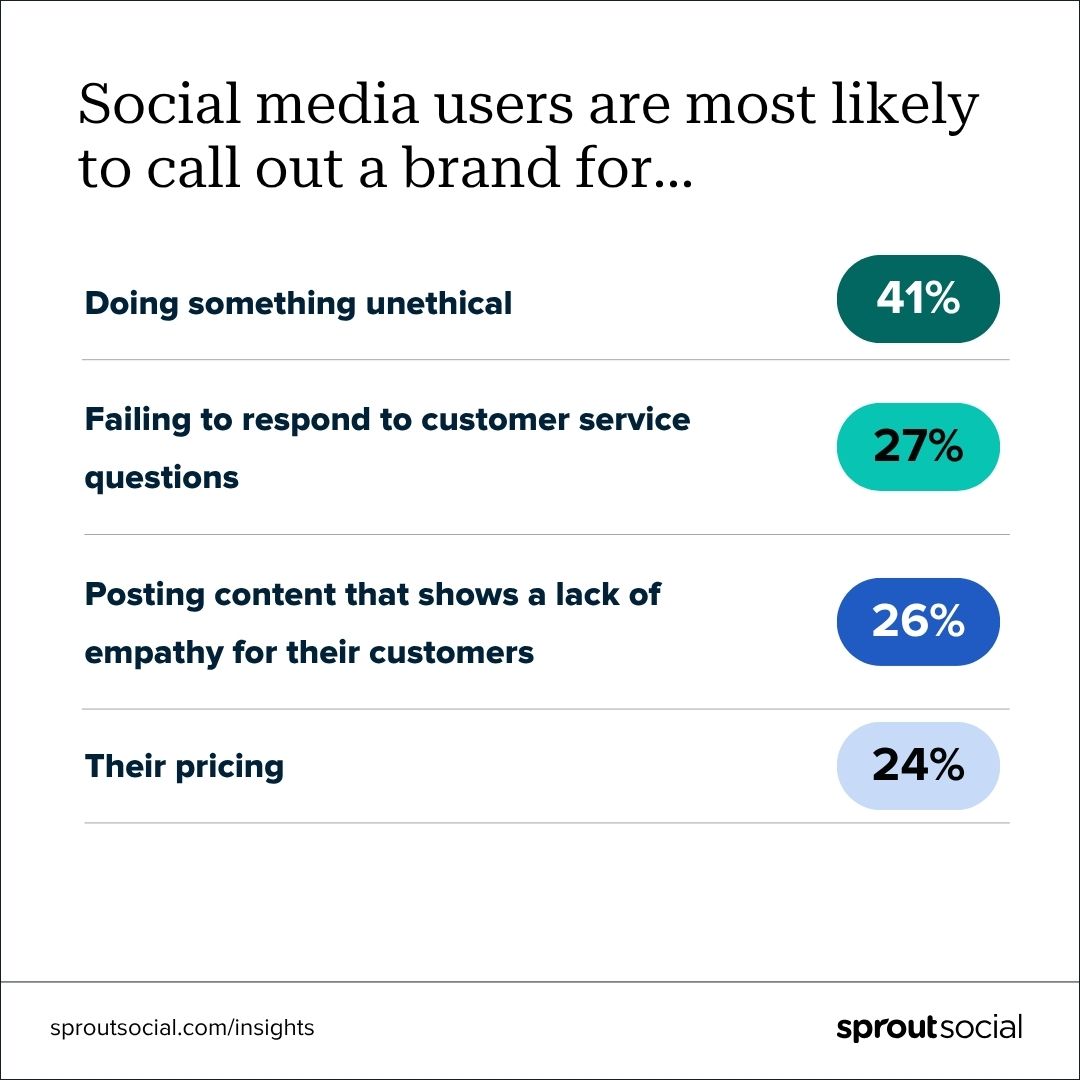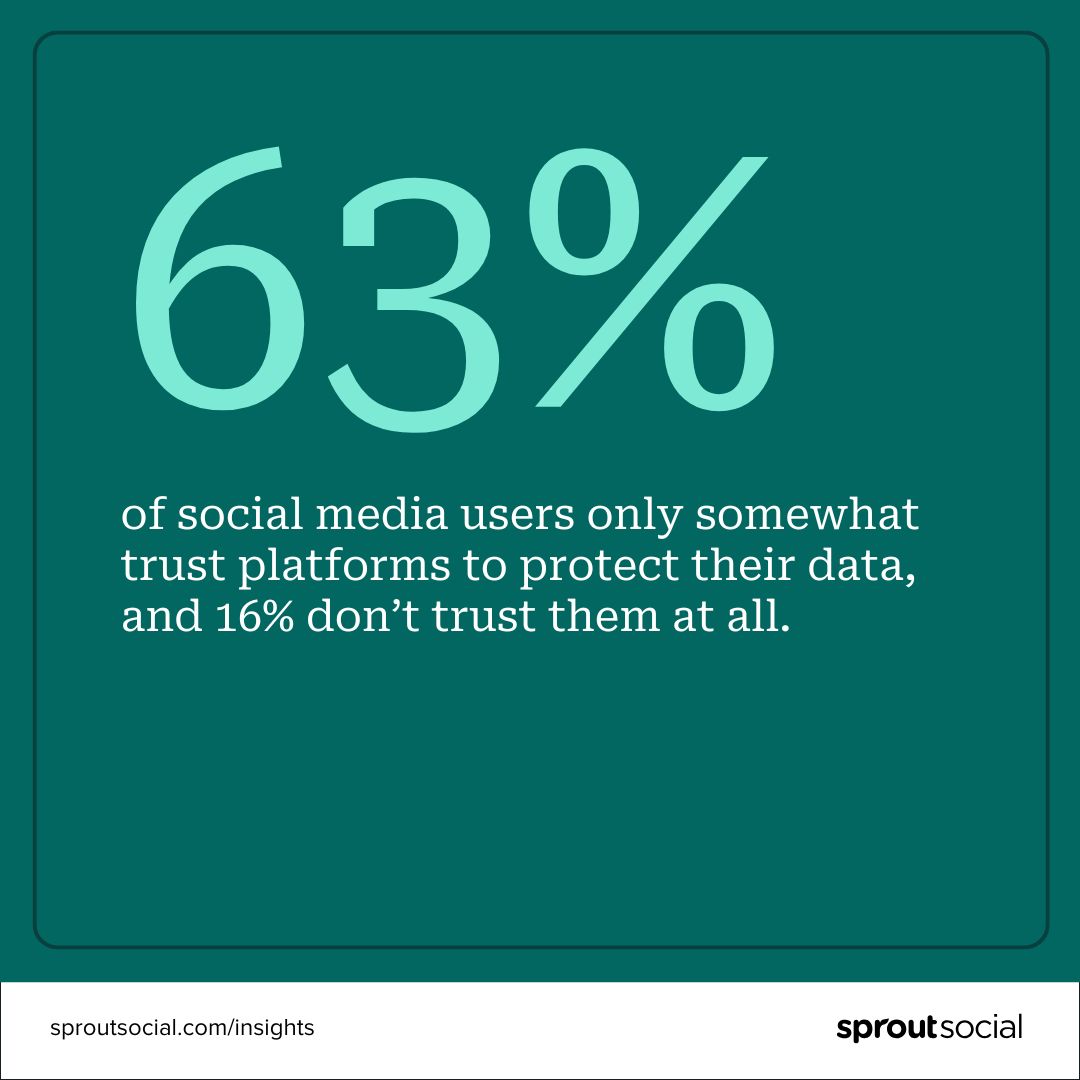Is the influencer in that publish really human? That advert… was it made by AI?
These social media advertising and marketing ethics questions are popping up extra typically—and getting tougher to reply—as generative AI works its manner into almost each nook of social media advertising and marketing, from content material creation to customer support.
AI now helps manufacturers write captions, generate photos, analyze developments and even reply to feedback. However as these instruments turn out to be extra highly effective and widespread, so do the issues surrounding AI ethics, authenticity, information privateness and viewers belief.
What occurs when personalization crosses the road into manipulation? What in case your influencer marketing campaign is powered extra by algorithms than actual individuals?
It’s simpler than ever to maneuver quick and scale up your social media advertising and marketing efforts. However incomes belief nonetheless takes work.
On this article, we’ll discover how social media advertising and marketing ethics are evolving within the age of AI, and what’s at stake for manufacturers that don’t sustain.
How social media advertising and marketing ethics are altering (and why manufacturers want to concentrate)
5 years in the past, social media advertising and marketing was nonetheless principally human-led. AI instruments had been round, however they had been extra behind-the-scenes (see: chatbots and fundamental analytics).
At the moment, AI is in every single place. It generates content material and influences what individuals see and consider on-line.
Earlier than we dive into the core social media ethics pillars, let’s take a more in-depth have a look at how the panorama has shifted. These adjustments convey new moral concerns and implications for manufacturers and social media entrepreneurs.
As new developments emerge, extra social media moral concerns do too
5 years in the past, social media advertising and marketing ethics issues had been principally round information privateness, pretend information and influencer transparency.
- The Cambridge Analytica scandal confirmed how simply person information might be misused, resulting in widespread mistrust and stronger privateness legal guidelines like GDPR and CCPA.
- Deepfakes began going viral, elevating new questions on consent and misinformation.
- UK regulators had been additionally cracking down on influencers who didn’t disclose paid partnerships.
At the moment, those self same points are evolving in additional advanced methods.
- Most generative AI fashions are educated on large datasets scraped from the web, elevating questions round plagiarism and privateness.
- The road between “actual” and “automated” is blurring. The problem now’s much less about recognizing AI and extra about utilizing it in a manner that aligns together with your model and values.
- The accountability for moderation is shifting from platforms to manufacturers. If a marketing campaign is biased, inaccurate or offensive, you’re nonetheless accountable. AI or influencer involvement doesn’t change that.
All these concerns imply manufacturers have to pay nearer consideration to what they’re publishing and who’s reviewing it. The extra automated your content material turns into, the extra lively your social media ethics oversight must be.
Why it issues: The direct hyperlink between moral practices and enterprise outcomes
Moral advertising and marketing isn’t simply the correct factor to do. It’s the sensible factor to do. Your persons are paying shut consideration to how you utilize AI and present up on-line. And the implications for getting it fallacious hit quick and laborious.
In accordance with our Q2 2025 Pulse Survey, the most important group of social media customers (41%) stated they’re most certainly to name a model out for doing one thing unethical than for some other purpose.

The influence doesn’t cease at clients. A 2025 Pew Analysis report discovered that over half of U.S. staff (52%) are anxious about how AI will have an effect on their jobs, and a 3rd (33%) really feel overwhelmed. Manufacturers that fail to deal with these fears danger shedding inside belief and expertise.
And buyers are watching, too. A 2025 report confirmed that AI-related lawsuits greater than doubled on account of “AI washing”—a rising development the place firms are utilizing AI extra as a advertising and marketing gimmick than a real core function of their product.
Briefly, social media ethics missteps don’t simply injury status. They influence income, retention and long-term model relevance.
The core pillars of social media advertising and marketing ethics as expertise evolves
You know the way individuals like to joke that “the intern” is operating a model’s social media, when it’s sometimes a highly-skilled workforce or senior skilled? The identical goes for AI.
It could possibly assist streamline and scale, nevertheless it’s not able to run the present by itself. With out oversight, even probably the most modern instruments—or influential creators—can publish content material that’s doubtlessly dangerous or deceptive.
That’s why manufacturers want clear social media advertising and marketing ethics guardrails, which we’ll dive deeper into within the subsequent part.
Honesty and transparency
“Trustworthy” was the highest trait social media customers related to daring manufacturers, in line with our Q2 2025 Pulse Survey, outpacing humor and even relevance. That’s no accident. When manufacturers are open about their operations, they earn belief. And belief is the inspiration of long-term loyalty.
Honesty additionally helps manufacturers keep forward of crises and misinformation. Missteps unfold quick on-line.
However when a model has a monitor file of transparency, audiences usually tend to give it the good thing about the doubt.
Take Rhode Magnificence. In 2024, creator Golloria George posted a viral overview criticizing the model’s blush vary for missing shade range. Lower than a month later, she shared that Hailey Bieber had personally reached out, despatched up to date merchandise and even compensated her for “shade consulting.” Rhode was praised for the way they dealt with the state of affairs and acted with transparency.
Being open additionally protects your model’s status and long-term sustainability.
Unilever is one other robust instance. As the corporate quickly scales influencer partnerships, it’s utilizing AI instruments to generate marketing campaign visuals. However they’ve been clear about how and why they’re doing it. This openness alerts that whilst they transfer quick, they’re doing so responsibly.
Information safety and client privateness
AI permits entrepreneurs to research large quantities of person information to personalize content material and predict habits. However simply because you may gather and act on that information doesn’t imply you all the time ought to.
In accordance with Sprout’s This autumn 2024 Pulse Survey, 63% of social media customers solely considerably belief platforms to guard their information, and 16% don’t belief them in any respect. That belief hole needs to be a wake-up name.

To earn that belief, entrepreneurs should be clear and considerate about how they gather and interpret information. For instance, instruments like social listening and sentiment evaluation supply helpful insights, however they’re removed from good. They’ll misinterpret tone, sarcasm or cultural nuance, particularly throughout various communities. Put an excessive amount of religion in them, and also you would possibly overlook what your viewers is absolutely saying.
Defending client privateness begins with transparency. Let your viewers understand how you’re utilizing AI and social listening instruments. Have a transparent and up-to-date privateness and social media coverage. Supply opt-outs for customized content material, and solely gather what’s really crucial. Most significantly, use these instruments to tell, not change, human judgment.
Spotify is an efficient instance of each side of this stability. Their Wrapped marketing campaign is broadly liked as a result of it makes use of listener information in a enjoyable, opt-in manner that feels private. However the model additionally confronted criticism for leaning closely on generative Al in final 12 months’s marketing campaign.
The takeaway? Persons are prepared to share their information, so long as manufacturers clearly clarify what they’re amassing, why they’re utilizing it and the way it provides worth.
Disclosing commercials and use of AI
Most entrepreneurs know the drill in the case of disclosing paid partnerships.
Nations just like the U.S., Canada and the U.Okay. have clear tips round sponsored content material. And if influencers don’t disclose, manufacturers may be held accountable. These guidelines defend shoppers and model status, since unclear model partnerships can rapidly backfire.
Sprout’s This autumn 2024 Pulse Survey discovered that 59% of social customers say the “#advert” label doesn’t have an effect on their probability to purchase. Nonetheless, 25% say it makes them extra more likely to make a purchase order. That tells us disclosure doesn’t scare individuals off, however it will probably assist manufacturers achieve favor with acutely aware shoppers.
Now that very same expectation is extending to AI-generated content material. A 2024 Yahoo research discovered that disclosing AI use in adverts boosted belief by 96%.
Regulators are additionally taking notice. Within the U.S., the Federal Commerce Fee (FTC) warned manufacturers that failing to reveal AI use might be thought of misleading, particularly when it misleads shoppers or mimics actual individuals. The EU’s new AI Act and Canada’s proposed Synthetic Intelligence and Information Act are additionally pushing on this path.
Clorox is one model getting forward of the curve. They’re utilizing AI to create visuals for Hidden Valley Ranch adverts, and being upfront about it. That form of proactive transparency builds credibility in a fast-changing area.
Respect and inclusivity
Respect and inclusivity present up within the day-to-day selections manufacturers make on social. That features the language they use, the individuals they spotlight, how they reply to suggestions and their dedication to accessibility.
Bias typically slips in subtly. Like social algorithms favoring content material and creators which have traditionally carried out properly, leaving marginalized voices out. Or manufacturers unintentionally posting content material that feels tone-deaf. Like a health model would possibly assume everybody has the time, area or bodily potential to work out every day. What’s meant to inspire one particular person can alienate one other.
Inclusive manufacturers work to catch these blind spots. They take heed to suggestions, design with accessibility in thoughts and intention to mirror a variety of lived experiences of their content material. Social media accessibility—like utilizing alt textual content, captions, and excessive shade distinction—is an enormous a part of this effort.
Ben & Jerry’s is a powerful instance of values-led content material. They constantly weave their stance on social points into their content material. Living proof: in June 2025, they used the “propaganda we’re not falling for” development to name out dangerous narratives they reject, like anti-abortion campaigns and greenwashing, reinforcing their long-standing dedication to inclusive activism.
How manufacturers can keep up-to-date with tips and self-regulate
Social media advertising and marketing ethics are shifting quick. From evolving influencer FTC tips to navigating the TikTok ban to new EU governance legal guidelines, manufacturers want to remain knowledgeable on the newest adjustments (and adapt accordingly).
Listed here are just a few sources we suggest bookmarking (apart from our weblog, in fact!):
Newsletters
- Advertising and marketing Brew: Each day information on adverts, social developments and coverage shifts
- Future Social: Creator and social technique insights from strategist Jack Appleby
- ICYMI: Weekly platform, creator and social information from advertising and marketing guide Lia Haberman
- Hyperlink In Bio: A e-newsletter for social media execs from social media guide Rachel Karten
Trade information websites
Regulatory our bodies
- FTC: U.S. promoting and influencer disclosure tips
- Advert Requirements Canada: Moral advert requirements and influencer guidelines
- ASA: UK’s promoting watchdog
- EDPB: GDPR and AI use steering throughout Europe
AI ethics
- Partnership on AI: A worldwide org providing frameworks and ideas for moral AI use
Prioritize model and social media ethics now and sooner or later
Moral advertising and marketing can really feel overwhelming. There’s so much to recollect: platform guidelines, disclosure necessities, accessibility requirements, the listing goes on. And in case you’re making an attempt to do every thing completely, it will probably really feel like strolling a tightrope.
However right here’s the factor: you gained’t all the time get it proper. And that’s okay.
Simply preserve the next issues in thoughts:
- In an moral gray space? Transparency is your greatest software. Let individuals understand how you’re utilizing AI. Clearly disclose all model partnerships. Be trustworthy and upfront about what you’re doing and why.
- Intentions depend, however so does accountability. If somebody calls you out, the way you reply issues simply as a lot as what you probably did.
- Construct social media advertising and marketing ethics into your workflows. Create checklists, write inside tips and loop in authorized or compliance groups as wanted.
- Lastly, keep curious. Tech and rules are evolving quick. Alter and adapt as you go by recurrently auditing your instruments, tips and processes and gathering suggestions out of your viewers and workforce.
Undecided the place to start? Our Model Security Guidelines gives sensible tips about learn how to defend your model from reputational threats.
Social media is consistently altering. However you don’t should be reactive. Lead with values and arrange sensible techniques and also you’re already forward.






